This is a fact-based comparison of Salesforce® and Microsoft Dynamics™ 365.
For those who work for an organization that is moving toward a new CRM solution, the information below is a starting point.
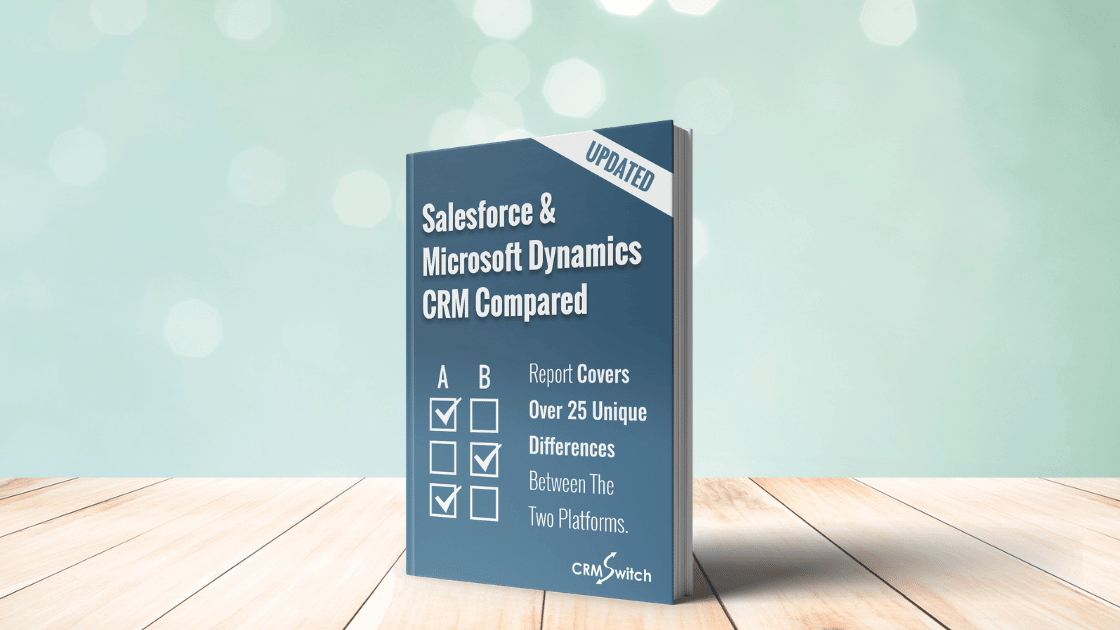
While we have attempted as much as possible to keep this analysis a statement of facts, we expect that advocates for each solution will find areas that appear slanted in the direction of the other.
The analysis primarily focuses on out-of-the-box functionality. We have intentionally limited the number of references to third party products.
With continuous improvement to each product, there will always be certain feature/functionality information that’s out of date. Pricing plans are also in an ongoing state of flux. We will periodically update this post with the most recent information.
Company and Product Branding
While salesforce.com, inc. is the official company name, the company and product are now both publicly referred to as “Salesforce”.
Up until November 1, 2016 Microsoft Dynamics 365 was known as Microsoft Dynamics CRM Online. “CRM” no longer appears in the brand or product names.
In 2020, Microsoft has moved even farther away from traditional “CRM” and “ERP” product naming and functionality conventions. Microsoft Dynamics 365 solutions are now individually licensed apps that offer different tools for different departmental or organizational needs, including Sales, Marketing, Service, Finance, Operations, Commerce, and HR.
Company Backgrounds
Salesforce.com, Inc.
Salesforce was founded in 1999 by former Oracle executive Marc Benioff, and went public June 2004. Salesforce.com was a pioneer in developing software as a service (SaaS) which is now commonly referred to as cloud computing. The company has stated that it has over 150,000 CRM customers.
Salesforce.com, Inc. is traded on the NYSE under the symbol CRM.
Microsoft Corporation
Microsoft was founded in 1975 by Paul Allen and Bill Gates. Microsoft is best known for its Microsoft Windows operating system and the Microsoft Office suite of software. A successful, although lesser known product line, is Microsoft SQL Server, which is used as the database back end for Microsoft Dynamics 365.
Microsoft has also developed consumer hardware products such as the Zune and Xbox. Microsoft has expanded to the Web with products such as the Bing Search Engine. In 2012, Microsoft acquired Yammer, the developer of a popular enterprise collaboration application of the same name.
In 2016, Microsoft acquired LinkedIn. In June of 2018, Microsoft announced the acquisition of GitHub.
Microsoft Corporation is traded on NASDAQ under the symbol MSFT.
Product Overviews
Salesforce
Salesforce only offers its product as a hosted, subscription model. It does not offer an on-premises version.
Furthermore, Salesforce is only available on a multi-tenant, shared instance platform. With Salesforce, there are no options for a dedicated instance or a dedicated server for a given customer.
While Salesforce has achieved high scalability for its application, for a variety of reasons, it has split its offering into multiple instances.
To supplement its core product offering, Salesforce has acquired a number of other technology companies in the CRM and social media spaces. Acquisitions include Jigsaw, Radian6, Buddy Media, Assistly, Heroku, ExactTarget, SteelBrick, DemandWare and Mulesoft.
Salesforce internally developed a collaboration product called Chatter. Chatter is available within all Salesforce editions at no extra charge.
New Releases
Salesforce has three major new releases each year. The release names are based on the season and year. An example is, “Winter ’21”. For the most part, these new releases are fully transparent with respect to existing customizations. Customers do not have to pay extra for new releases.
Salesforce provides extensive release notes in advance of each new release.
Editions and Pricing
Salesforce’s Sales Cloud is available in four different editions. The editions are the same underlying product, with specific features and functionality either switched on or off, depending on the edition. The minimum contract term is 12 months. A longer term commitment, such as 24 or 36 months, can result in lower pricing.
| Sales Cloud Edition | Per User Per Month Cost |
| Unlimited | $300 |
| Enterprise | $150 |
| Professional | $75 |
| Essentials (up to 5 users) | $25 |
Salesforce has a variety of other packages, including:
- Service Cloud
- Sales + Service
- Marketing Cloud
- Engagement Cloud
- Health Cloud
- Financial Services Cloud
- CPQ
- Quip
Some packages are alternatives to Sales Cloud. Some can be added to Sales Cloud. For example, CPQ, Quip and Marketing Cloud can all be added to Sales Cloud.
Salesforce.org provides free and/or deeply discounted licenses to certain categories of organizations such as 501(c)(3) corporations and B corporations.
Data Storage
All editions of Salesforce have a minimum of 1GB of data storage or 20MB times the number of users, whichever is higher.
Lower editions of Salesforce have 10GB of document storage or 612MB times the number of users, whichever is higher. Enterprise Edition and higher have the 10GB base or 2GB times the number of users.
Each record in most Salesforce objects is deemed to use 2 KB of storage. Additional data storage can be purchased in 50 MB or 500 MB increments. Additional file storage can be purchased in 10GB increments.
Microsoft Dynamics 365
Microsoft has two main versions of its product, Microsoft Dynamics CRM (on-premises or private cloud) and Microsoft Dynamics 365 (cloud) — the focus of this comparison.
Microsoft Dynamics 365 is multi-tenant at the application level, but single tenant on the database level — each account has its own SQL Server database.
New Releases
Microsoft follows an agile release cycle for CRM and targets two to three releases annually with service updates as required. Microsoft has a What’s New page with a link to a downloadable release notes PDF.
Microsoft has announced that Dynamics 365 will move to a twice-yearly update schedule.
For the most part, these new releases are fully transparent with respect to existing customizations. Customers do not have to pay extra for new releases.
Editions and Pricing
Dynamics 365 Sales pricing depends on whether Sales is a user’s first or subsequent qualifying Dynamics app.
For the first Dynamics app (for a user), pricing is as follows:
| Edition | Per User Per Month Cost |
| Sales Professional | $65 |
| Sales Enterprise | $95 |
| Sales Premium | $135 |
| Microsoft Relationship Sales | $162 |
If a user already has a qualifying Dynamics 365 license, the price of Sales Professional drops from $65 to $20 per month for that user. The price drops from $95 to $20 per month for Sales Enterprise.
Microsoft Relationship Sales integrates the LinkedIn Navigator experience with Dynamics 365.
This downloadable PDF explains Dynamics 365 licensing in detail.
Let us know if you would like to be connected to a partner for help with navigating pricing options.
Data Centers and Status
Salesforce
Salesforce’s service is collocated in multiple, top-tier global data centers. Salesforce publishes its data center security information on its trust.salesforce.com site.
Salesforce does not own the data centers in which its customers are hosted. According to Salesforce, “We’ll continue to work with a variety of infrastructure technology vendors and partners across its own data centers, as well as new public cloud-based data centers, in order to deliver the best service possible to customers.”
Salesforce does not have a publicly accessible Service Level Agreement (SLA).
Microsoft Dynamics 365
Microsoft Dynamics 365 is powered by Microsoft Azure, the second largest public Cloud provider. Microsoft invests about $1 billion in cloud security each year.
As of 2017, Microsoft operates more than 100 data centers to serve more than 12 million subscriber organizations. That’s an overall market share of about 11%, and represents a large investment.
Data center security and status features include:
- Access control: Microsoft data centers are protected by perimeter fencing, security officers, locked server racks, multi-factor access control, integrated alarm systems, and around-the-clock video surveillance. Employee access to data centers is restricted by job function.
- Disaster safeguards: Each data center features fire suppression technology, and servers in high risk regions are built on seismically braced racks. Data centers are also equipped with two power feeds, as well as both battery and diesel generator backups.
- Redundant regional data centers: Microsoft’s vast network of data centers ensures a problem at one won’t cause downtime or data loss, while the sheer size of the network practically guarantees both local hosting and global availability.
- Information security management: Microsoft’s data centers are all ISO-27001 certified.
- Guaranteed uptime: Microsoft guarantees 99.9% uptime in the Dynamics 365 Sales service level agreement (SLA).
Mobile Device Support
Salesforce
Salesforce mobile device platform is called The Salesforce Mobile App. Salesforce publishes an app for iOS and one for Android.
Using the Salesforce Mobile Platform, Salesforce apps can be built and customized and then deployed to the mobile devices.
Microsoft Dynamics 365
Microsoft offers both iOS and Android apps. The mobile app can be configured to display specific forms, fields and entities, including custom entities.
Third Party Ecosystem
Sometimes, business requirements drive the need for functionality that is only offered by third parties. Both Microsoft and Salesforce allow for running third party applications natively on their platforms.
Salesforce
Salesforce manages its own third-party application site, the AppExchange. The AppExchange also has applications from salesforce.com’s internal, Salesforce Labs.
All applications must be certified and pass a periodic security check. All AppExchange applications are installed with the same sequence of clicks.
Some of the apps are free and some are paid. Not all applications are compatible with all editions of Salesforce. For example, many apps require Lightning Professional or higher.
Microsoft Dynamics 365
Microsoft’s exchange is called AppSource. This site spans different Microsoft product lines including Dynamics 365, Power BI, Office 365 and Azure. Microsoft also has an internal app development team similar to Salesforce Labs.
Sales & Delivery Channels
For organizations that are considering both vendors, the way each product is sold factors into the close-up evaluation and buying process.
Salesforce
Salesforce is sold directly via a team of Account Executives and people in other named sales roles. Account Executives normally team up with a Salesforce partner when implementation services are requested by a prospect. Salesforce partners do not receive commission on license sales, even for deals they source.
Microsoft Dynamics 365
Depending on the size of the company, a new customer will either be directed to an inside salesperson or a dedicated new customer resource as the first point of contact.
The inside salesperson gets a Microsoft partner involved with potential deals that represent over a minimum annual subscription revenue. A Microsoft Cloud Solution Provider that is brought into a deal by an inside salesperson or who initiates a deal, receives a margin on the sale. Microsoft offers one level of margin for the first year subscription revenue and a lesser margin for subsequent years’ subscription revenue.
Major account deals are handled directly by a Microsoft outside salesperson.
Implementation Partner Selection
Selecting the right partner can be as important a decision as selecting the right vendor. Increasingly, CRM implementation partners are specialize in specific industries. Example industries are: healthcare & life sciences; financial services; manufacturing; software; and non-profit.
It’s important to find the right partner in terms of skills, responsiveness, geography and approach. In the end, it’s the partner that you will hold responsible for making your organization’s CRM dreams come true.
While CRM Switch does not provide CRM implementation services, we have a network of reputable Salesforce and Microsoft partners we’ve teamed up with.
Contact us for a recommendation.
Login and Password Security
Data breaches are on the forefront of many IT executives’ minds. It’s important to take a close look at technology vendor security models and options. Here’s a high level overview.
Salesforce
Salesforce defaults to two factor authentication for all users for org access. After a new user’s initial login, each time the user tries to login from an unrecognized computer or device, Salesforce emails or texts a verification code to the user. The user must key in the verification code in order to log into Salesforce. This two factor authentication can be overridden by the setting of Trusted IP Ranges by an administrator.
In Lightning Enterprise and higher, certain IP ranges can be restricted from login access altogether, as defined within user Profiles.
Salesforce offers an app called Salesforce Authenticator which is available for iOS and Android. This app provides a greater level of security than email or SMS based two factor authentication.
Salesforce allows for setting password policies, including: password expiration duration; how many old passwords are remembered; minimum password length; password complexity.
Salesforce supports authentication via identity providers such as Active Directory with the implementation of single sign-on (PDF).
Microsoft Dynamics 365
Microsoft Dynamics 365 users login via a Microsoft Office 365 account.
An administrator can set up multi-factor authentication for users in the Office 365 administration area.
Microsoft Dynamics 365 can be synchronized with Active Directory.
With a subscription to Azure Active Directory Premium, access to Dynamics 365 can be limited to users with trusted IP addresses.
UI & Navigation
The user experience is in transition for both vendors. Salesforce is moving from Classic to Lightning Experience. Microsoft has introduced a new UI, beginning with Sales Hub.
In both cases, one of the drivers was creating a consistent user experience across the desktop and mobile devices.
Salesforce
In August, 2015, Salesforce announced a redesigned platform called Lightning Experience. One component of Lightning is a refreshed user interface.
Lighting became available in the Winter ‘16 release. However, it will have been several years from the announcement before all of Salesforce’s customers have switched to the new platform, as Salesforce has been gradually releasing functionality to match what is available in “Salesforce Classic”.
The screenshots in this blog post are Lightning only.
General Navigation
Salesforce displays different objects as tabs across the top part of the screen. Each group of users who are in similar roles can have their own set (or sets) of tabs, as defined by “Apps”. An App is a collection of tabs that appears on the screen in a specific order. The App Launcher displays the apps that are available to a user.

When a tab in an app is clicked, the default list is Recently Viewed records for the object.
There is a global search box at the top of the browser window.
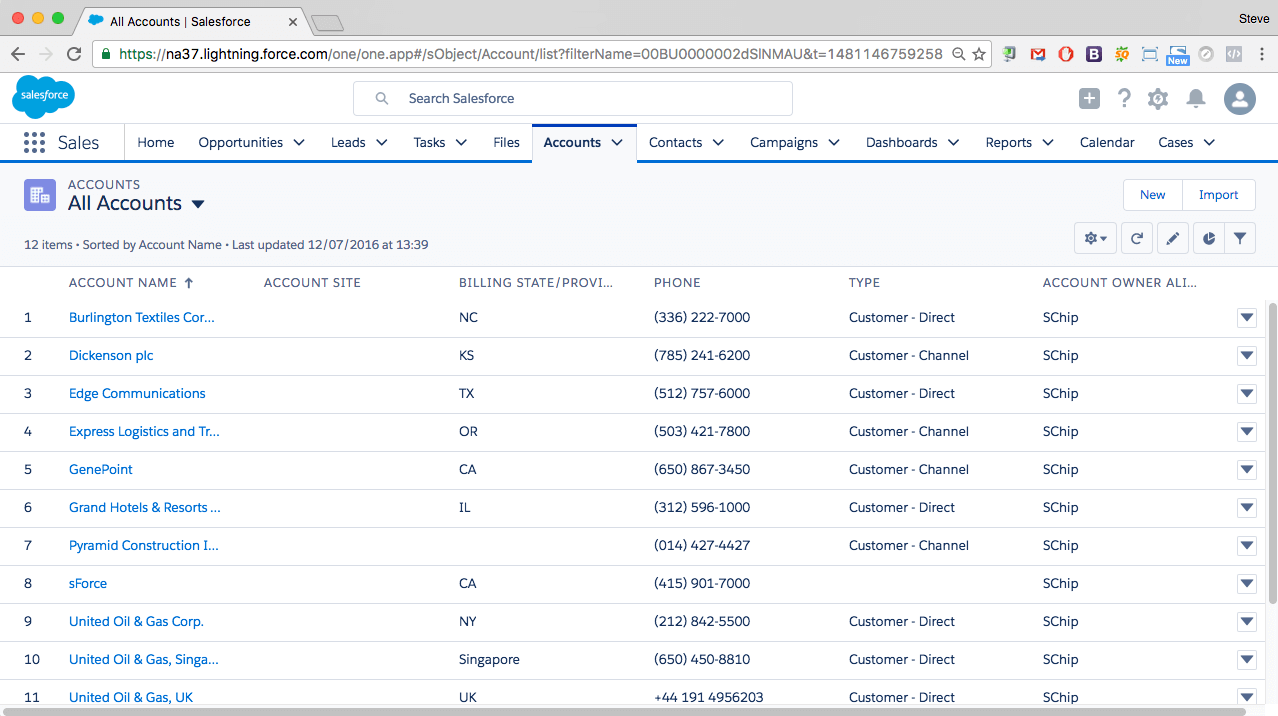
Record Navigation
Within each record, there is a Details tab that displays fields for the current record (and optionally fields from a parent record). The Related tab displays snippets of records from child objects. Activity information is in a separate section on the right side of the screen.
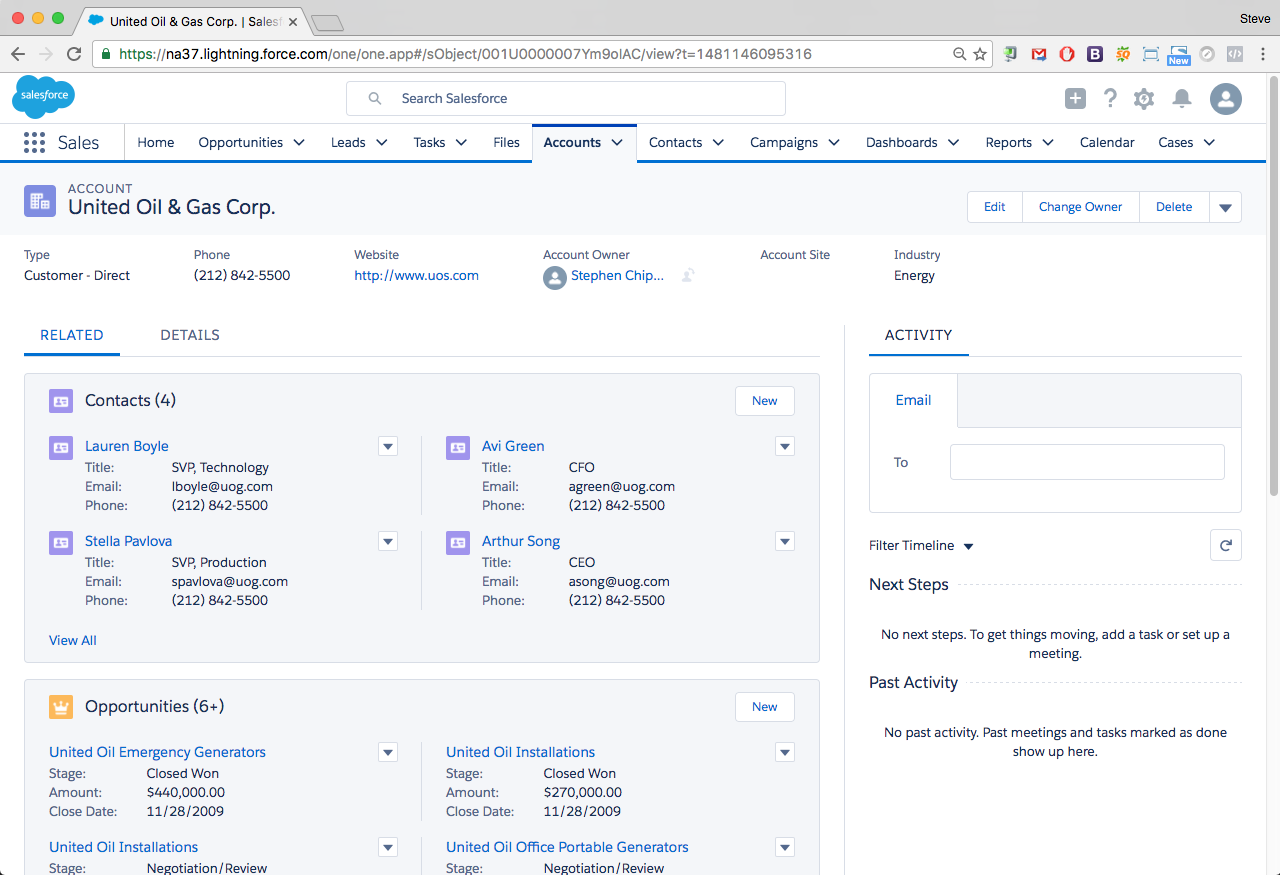
Microsoft Dynamics 365
Entity Selection
Microsoft Dynamics 365 displays permissioned functional areas of the application across top part of the screen. These areas are accessible by clicking on the down arrow to the right of the Sales menu.
Once an app has been selected, a user can click on the app name and see categorized entity links. Custom entities also appear on this screen. Depending upon security, permissions and configurations, more or fewer icons will appear.
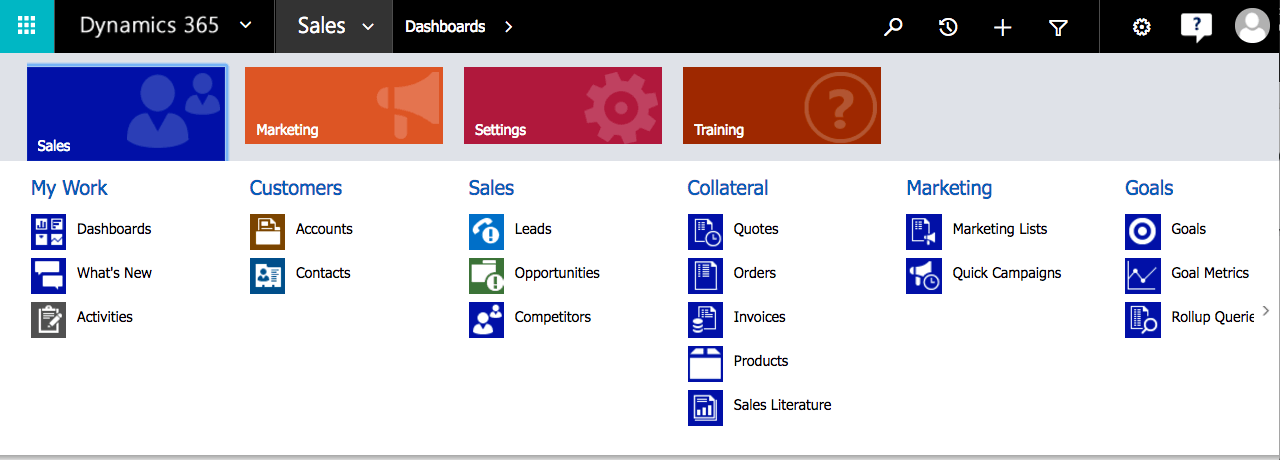
Recently Viewed Record Within an Entity
A user can see recently viewed records within an entity.

Related Record Lists Within an Entity Record
A user can see categorized, related lists within an entity record.

After an entity is selected, a filtered list of records within the entity, based on a View, is displayed. Users can select any system View or personal View and then optionally pin a View in order to make that View “stick”.
A Create button on the right side of the command bar allows users to quickly create new records without having to first navigate to an entity.
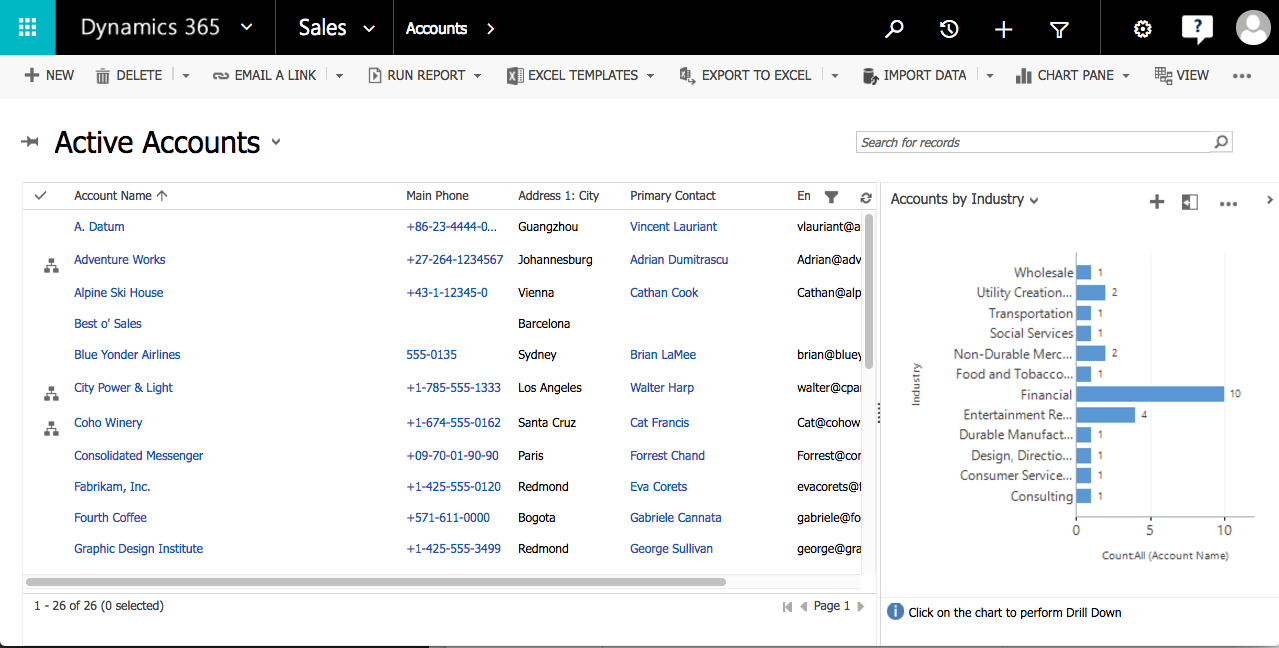
Once an entity, such as Accounts, is selected, a user can search within that entity using the search box, which is located to the top right of the list of records.
Record Navigation
There are two main sections to a record, Detail and Summary. There are twist down controls for each.
Record Summary Section
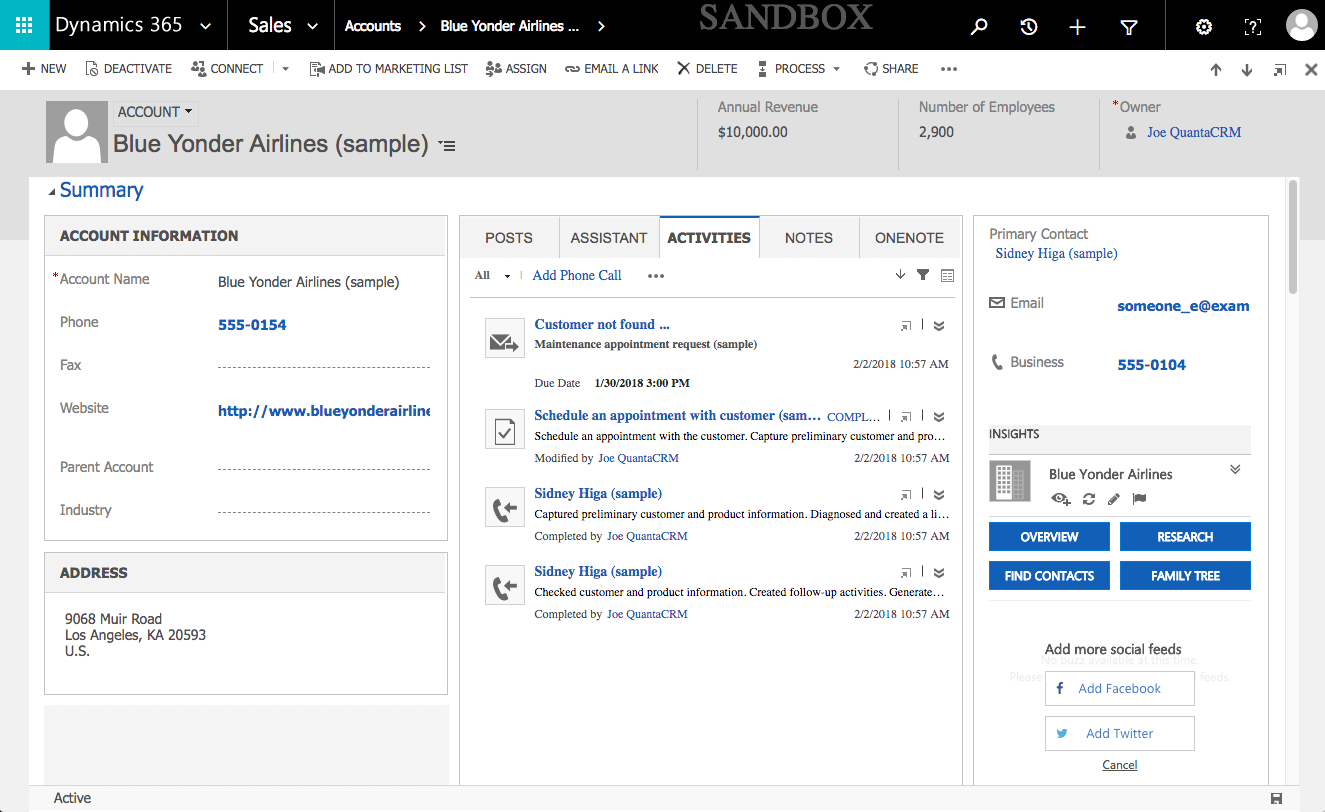
Record Detail Section
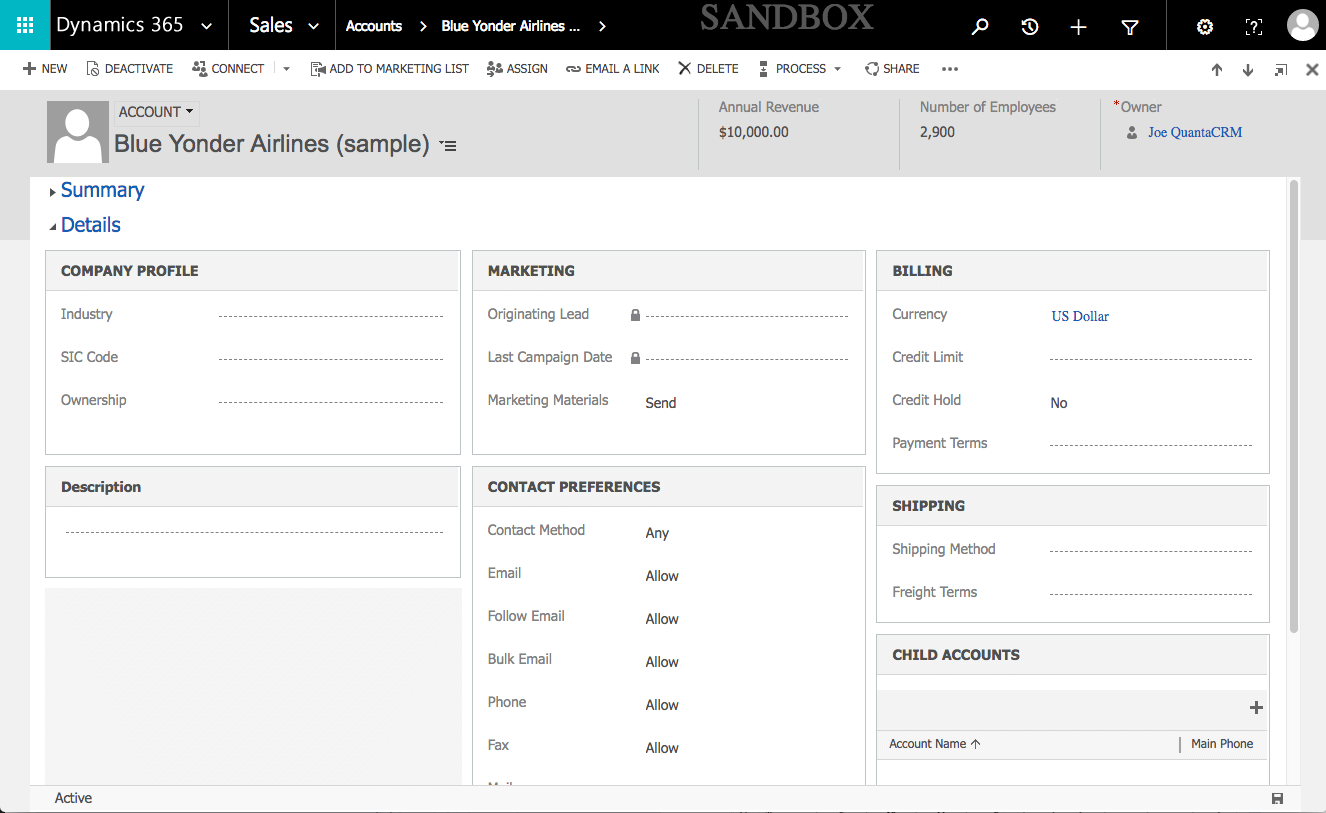
In the upper right of the screen, up and down arrows allow a user to go to scroll through other records within the current View.
Microsoft has introduced a new user interface called Sales Hub. The UI includes a vertical navigation bar.
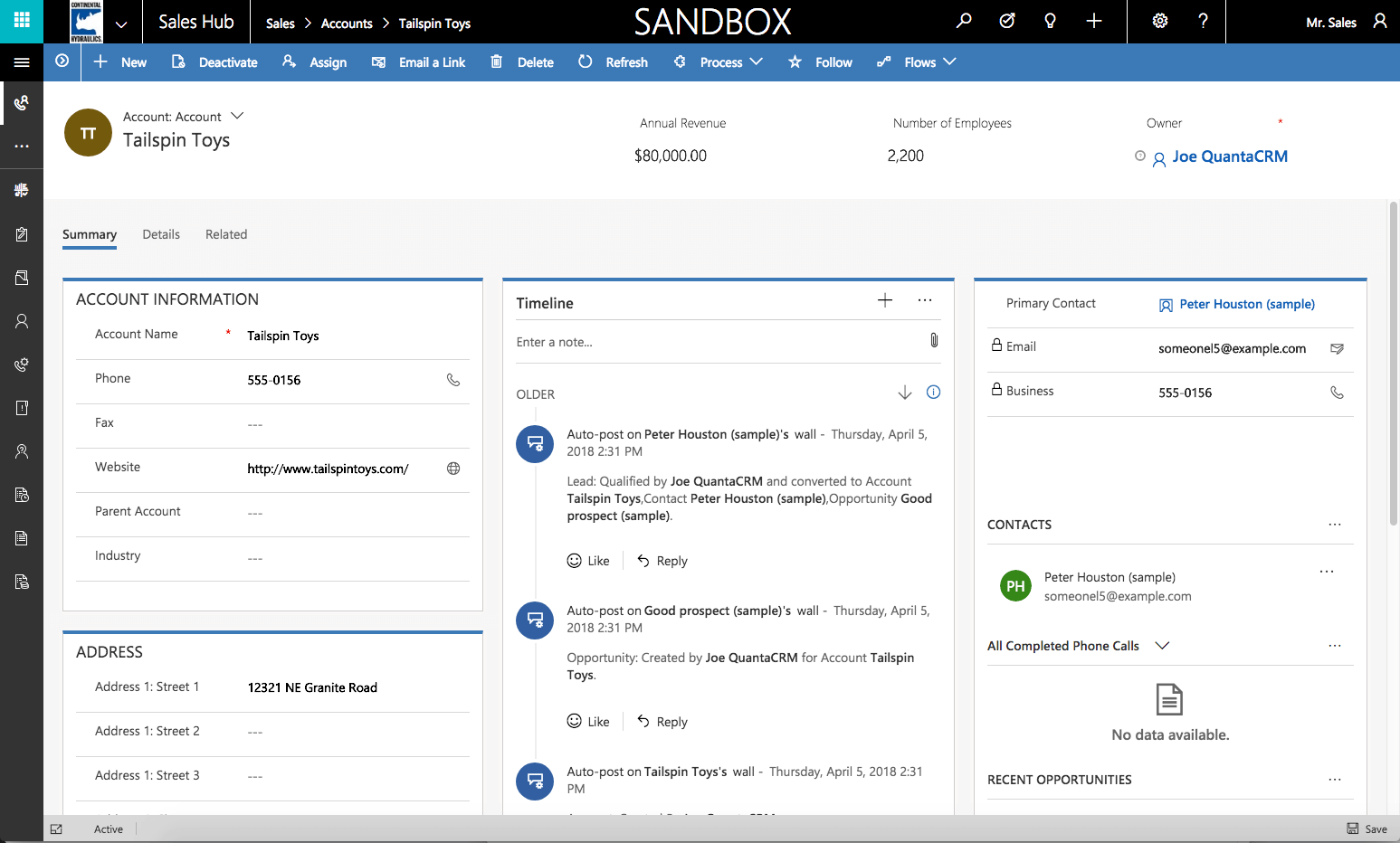
Variable Screen Layouts
At some organizations, not all users should see the same set of fields or have the same set of choices when editing a given record. Variable screen layouts allow for enhancing and restricting layouts on a per role or even a per user basis.
Salesforce
In the Enterprise edition and higher, there can be variable screen layouts per user based on the layout that is assigned to that user’s profile for a given object.
Multiple Record Types can also be created for objects. A Record Type can be associated with a specific screen layout and it can also dictate which picklist values are available in certain fields or which Sales Process users need to follow in the case of Opportunities.
The Record Type for a record is automatically enforced or is user selectable at the time of record creation. Depending on permissions, the Record Type can be changed after a record has been created.
Microsoft Dynamics 365
Microsoft Dynamics 365 allows for variable screen layouts by user. Different users can see different sets of fields in a record, as dictated by users’ functional roles within a company, for example.
There can also be different screen records based on type of record.
Example Use Case: Variable Layouts
A scenario for variable screen layouts is when only customer service users should have visibility to a customer’s credit limit and other financial information.
During the CRM planning phase, CRM Switch works with each department to ensure the selected system will providing only the information they need, formatted in the best way for viewing and editing.
User Options
It’s important for CRM users to be able to personalize their application experience beyond what an administrator configures and delivers to them.
Salesforce
Salesforce users have a wide variety of settings available via a left hand set of twist-down menu options.
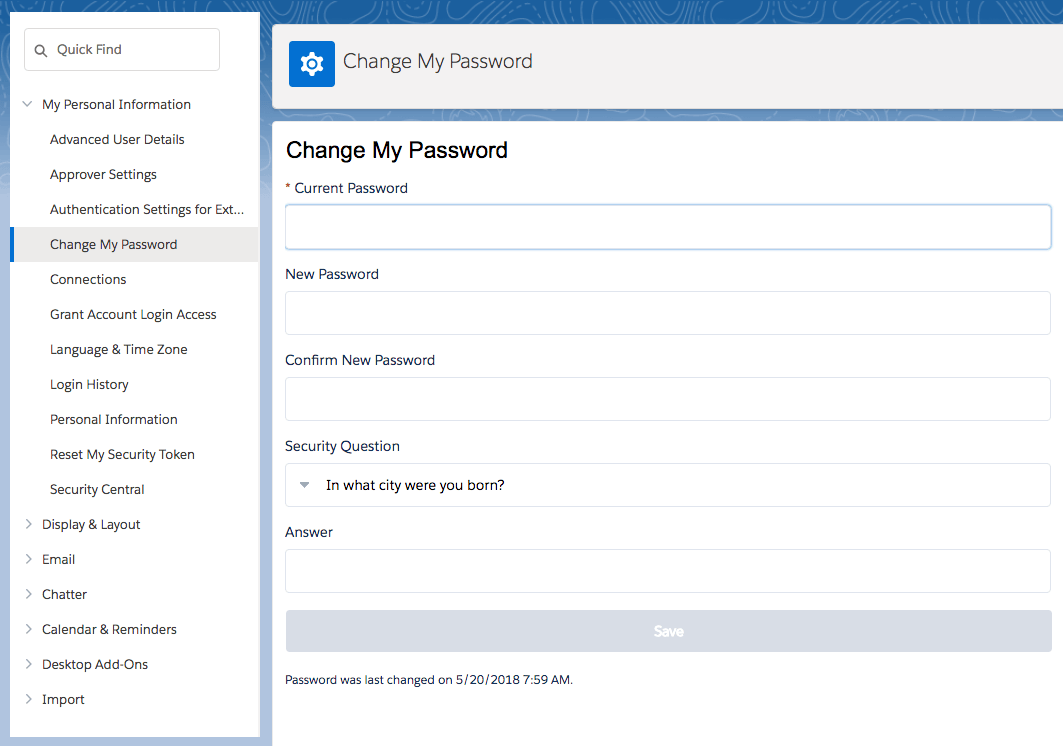
Microsoft Dynamics 365
Microsoft allows users to set a number of personal options, including their default pane and tab, their time zone and their currency.
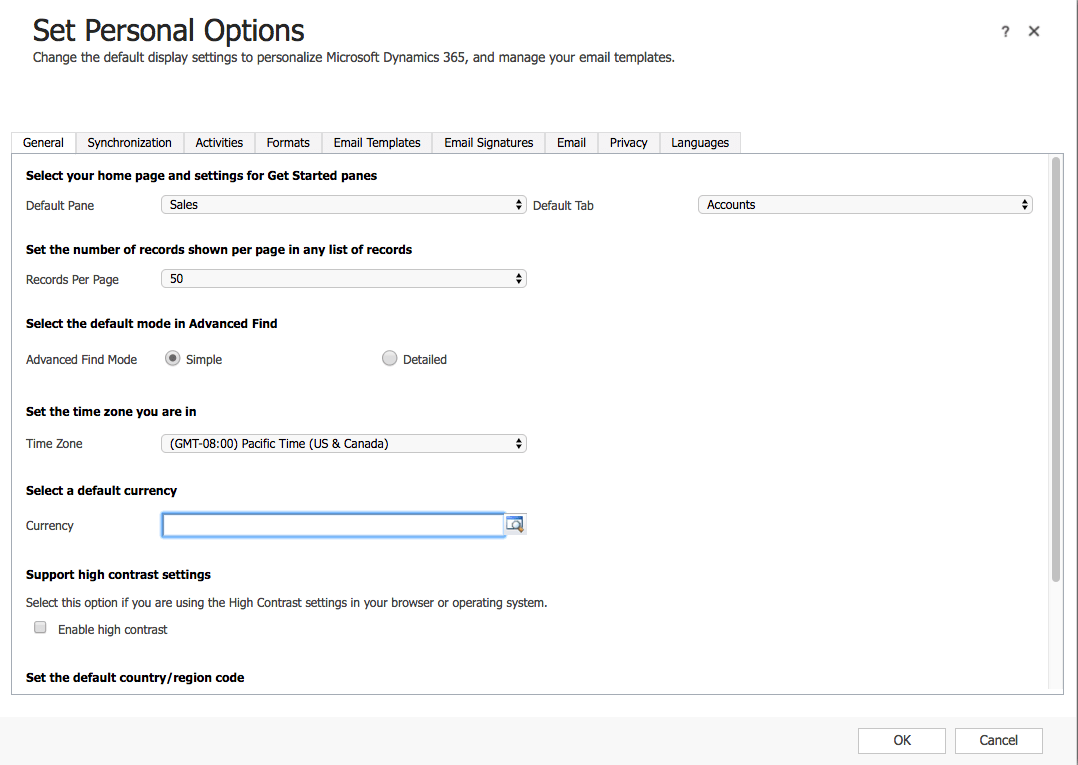
Microsoft Dynamics 365 offers a number of options around its email integrations.
Users can choose to automatically track all emails in response to messages already being tracked, all emails from Dynamics 365 Leads, Contacts and Accounts—or all emails. Alternatively, users can turn automatic email tracking off and manually choose which messages to add to Dynamics 365.
Similarly, users can elect to automatically create lead or contact records from tracked emails.
Point & Click Configuration and Customization
There are subtle differences in the types of fields that can be added to each application.
Salesforce
In Salesforce, an administrator can add new fields to an object via point-and-click. Field types include: Auto Number; Formula; Roll-up Summary; Lookup Relationship; External Lookup Relationship; Checkbox; Currency; Date; Date/Time; Email; Geolocation; Number; Percent; Phone; Picklist; Multi-Select Picklist; Text; Text(Encrypted); Text Area; Text Area (Long); Text Area (Rich); Time; URL.
Custom objects can also be added. A custom object can either have a lookup relationship with a parent object or a master-detail relationship. A many-to-many relationship between objects can be set up using a custom “junction” object.
Microsoft Dynamics 365
In Microsoft Dynamics 365, a System Administrator or System Customizer can add new fields to an entity via point and click. Custom field types are: Single Line of Text; Option Set (pick list); Two Options; Image; Whole Number; Floating Point Number; Decimal Number; Currency; Multiple Lines of Text; Date and Time; Lookup.
New entities can also be added. An entity can be related to another entity or entities as one-to-many, many-to-one or many-to-many.
There is also definable Relationship Behavior. Behavior can either be Parental or Configurable Cascading. There are a number of options related to the latter:

Example Use Case: Customer Surveys
One example of a custom object or entity is Customer Survey Results. Let’s say you want to send a customer a satisfaction survey link within each customer service “case closed” email. The link goes to a survey page.
Customer survey responses are stored in a custom entity or object in CRM that’s linked to the Account. This means visibility and reporting across all accounts and survey responses.
Advanced Development & APIs
Often, a business requires modifications to an out of the box CRM configuration that go well beyond what can be accomplished with declarative tools. ISVs build entire applications on top of CRM platforms. Here’s an overview of what Microsoft and Salesforce offer.
Salesforce
In the Enterprise and Unlimited editions, Salesforce allows for advanced customizations using Apex, Salesforce’s proprietary development language, as well as Visualforce, which is used for custom user interface design. Apex is also the language used for creating Triggers.
Advanced development for Salesforce is in transition between traditional Apex + Visualforce and the newer Lightning components.
Salesforce Enterprise and Unlimited have multiple APIs. APIs include SOAP Web Services, REST, a Bulk API and a Metadata API. Code examples in the API documentation are Java and C#, but the APIs can be called from a number of client side languages, including Ruby, PHP and Perl.
Salesforce provides a sandbox environment in the Enterprise edition and higher for developing and testing customizations and code. Lightning Enterprise’s included, developer sandbox can be created as a snapshot of the production org, but the sandbox does not inherit production data. It has a 200 MB storage limit. A full sandbox, which does inherit all data, is available for an additional monthly fee for the Enterprise Edition and higher. Another paid option is the developer pro sandbox, which has a 1 GB storage limit.
Salesforce also leverages the Eclipse open source IDE.
Microsoft Dynamics 365
Microsoft provides an SDK for advanced development and integrations.
Developers can write applications and server side extensions. Developers can also write client side application extensions. A developer can add JavaScript to add functions for when specific events occur on Microsoft Dynamics 365 forms. REST and SOAP endpoints are provided. The REST endpoint can be used for create, retrieve, update and delete from JScript and Silverlight web resources.
Developers have the ability to create custom business logic, workflow assemblies, and plug-ins. Microsoft Dynamics CRM for Microsoft Office Outlook can also be customized by a developer.
Visual Studio is needed for writing custom code and integrations, as .NET is used in Microsoft-supplied code libraries.
Microsoft Flow has integration between Dynamics 365 and over 300 premade integrations.
Search & Views
With many CRM users accustomed to the power of Google and Bing type search capabilities, it’s more important than ever for CRM vendors to offer a similar search experience.
Salesforce
Salesforce has stated that they pride themselves on a powerful global search. When a user enters a full text or partial text (wildcard) string in the Search box, Salesforce parses through all text fields (as well as several other field types, such as phone and email) within a standard set of objects, such as Accounts and Contacts. Search results are grouped by object.
A Search All link allows a user to expand the search across all objects, including Activities and Attachments.

Chatter feeds can also be searched for the same full or partial text string using the Search Feeds button.
Filter fields can be added to the search results for any object so that users can narrow the results of a global search. An administrator can add any fields from an object as filter fields within the search results for that object.
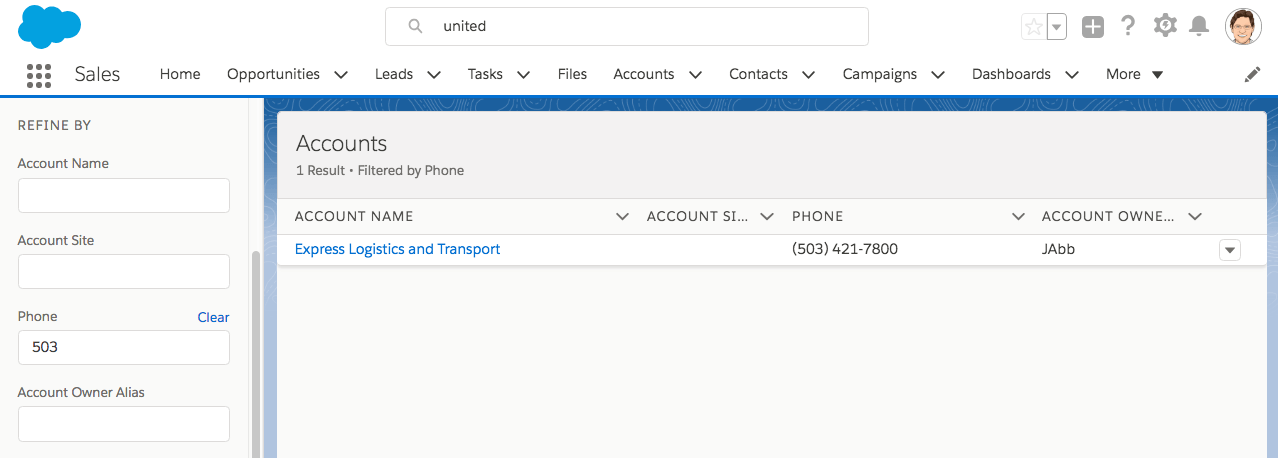
In Salesforce, Views can be used to create multi-condition, dynamic searches. Views only allow for filtering on fields within an object. Reports can be used to to view records based on cross-object filters.
Microsoft Dynamics 365
Microsoft Dynamics 365, has a global search box in the top right of the user interface.
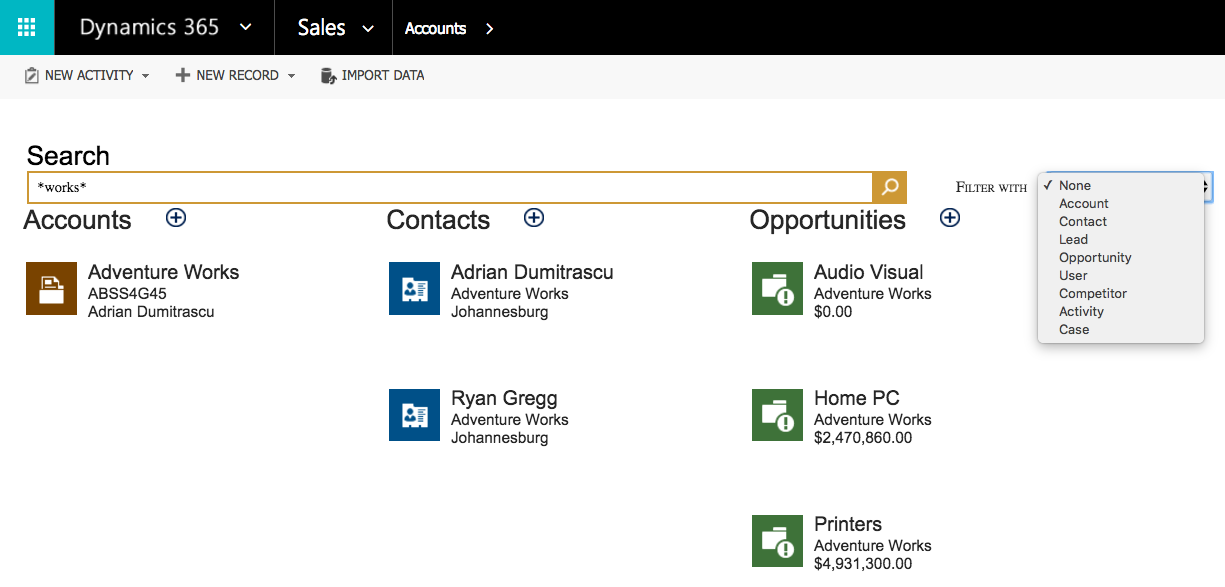
By default, the Global Search tool only returns results that begin with the keywords a user entered.
For example, if a user is looking for an account named City Power and Light and searches for “city,” the account will appear in the search results. But a search for the word “power” will not return the account, City Power in the results.
Wildcards allow a user to search for words that appear anywhere in a record. A wildcard in Dynamics 365 is an asterisk (*) preceding the search term.
From the previous example, if a user was to perform a global search for “power,” they would not see City Power and Light in the results. If they were to perform a global search for “*power,” they would see the results.
Wildcards also work for partial words, so a search for “*pow” would return City Power and Light.
Advanced Find is a more powerful and versatile search tool than Global Search. Advanced Find allows users to search and sort data by entity using multiple parameters. Results are presented in views, which can then be saved and added to the system for future reference.
Advanced Find is useful for complex searching and data visualization. It can be used to update records in bulk as well as for building custom reports and views.

Duplicate Detection and Merge
Duplicate records can diminish the user experience. Excessive duplication can decrease the overall success of a CRM implementation.
Salesforce
In Salesforce, duplicate rules work in conjunction with matching rules to prevent users from creating duplicate records.
A matching rule determines whether the record a user is creating or updating is similar enough to other records to be considered a duplicate. A duplicate rule tells Salesforce what action to take when potential duplicates are identified.
Custom duplicate and matching rules can be created.

Based on an alert, a user can merge up to three matching records into one. Salesforce provides a “stare and compare” interface for selecting the most appropriate field data for the Master Record (winning record) from each of the matching records. The losing record or records go into the Recycle Bin.
Microsoft Dynamics 365
In Microsoft Dynamics 365, duplicate detection runs as a background job. Duplicate Detection Rules are definable by an administrator.
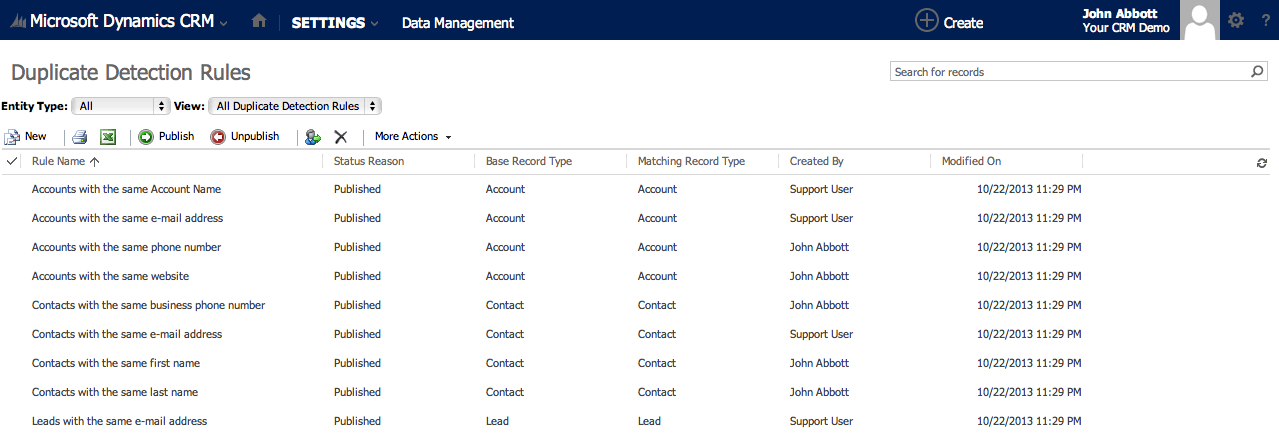
An entire entity or a subset of records within an entity can be checked for duplicates. After a duplicate detection job has completed, the user receives a notification email and can also check for the job results.
Duplicate Detection Rules are also run when a record is manually added or is imported. If a suspected duplicate is added based on a Rule, a dialog pops up to inform the user that they may be creating a duplicate.
Microsoft Dynamics 365 allows duplicate detection to be enabled for custom entities.
In Microsoft Dynamics 365, two records can be merged into one using a stare and compare interface. The “losing” record is marked as Inactive.
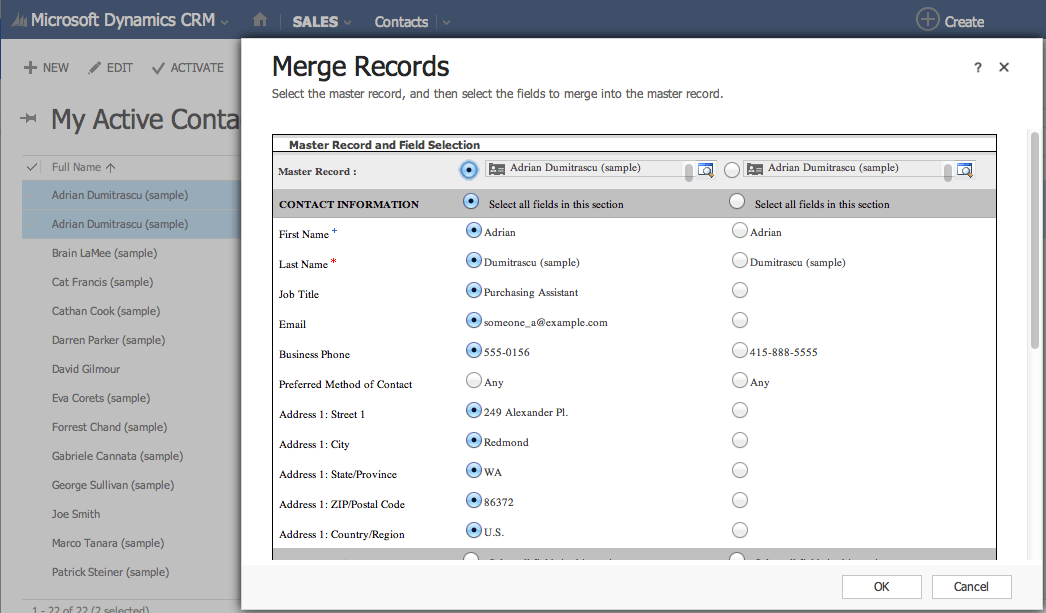
Workflow & Processes
Process automation can enforce company procedures and standards. Automating processes improves employee productivity. Both products have multiple options for building processes.
Salesforce
Salesforce offers Workflow Rules, Flows and Process Builder. The latter two have graphical components.
A Process can be triggered by a change to a record, an event or another Process. Actions happen automatically, be based on a set of conditions being met, or be based on a formula that evaluates to true. Actions can be immediate or based on a schedule.
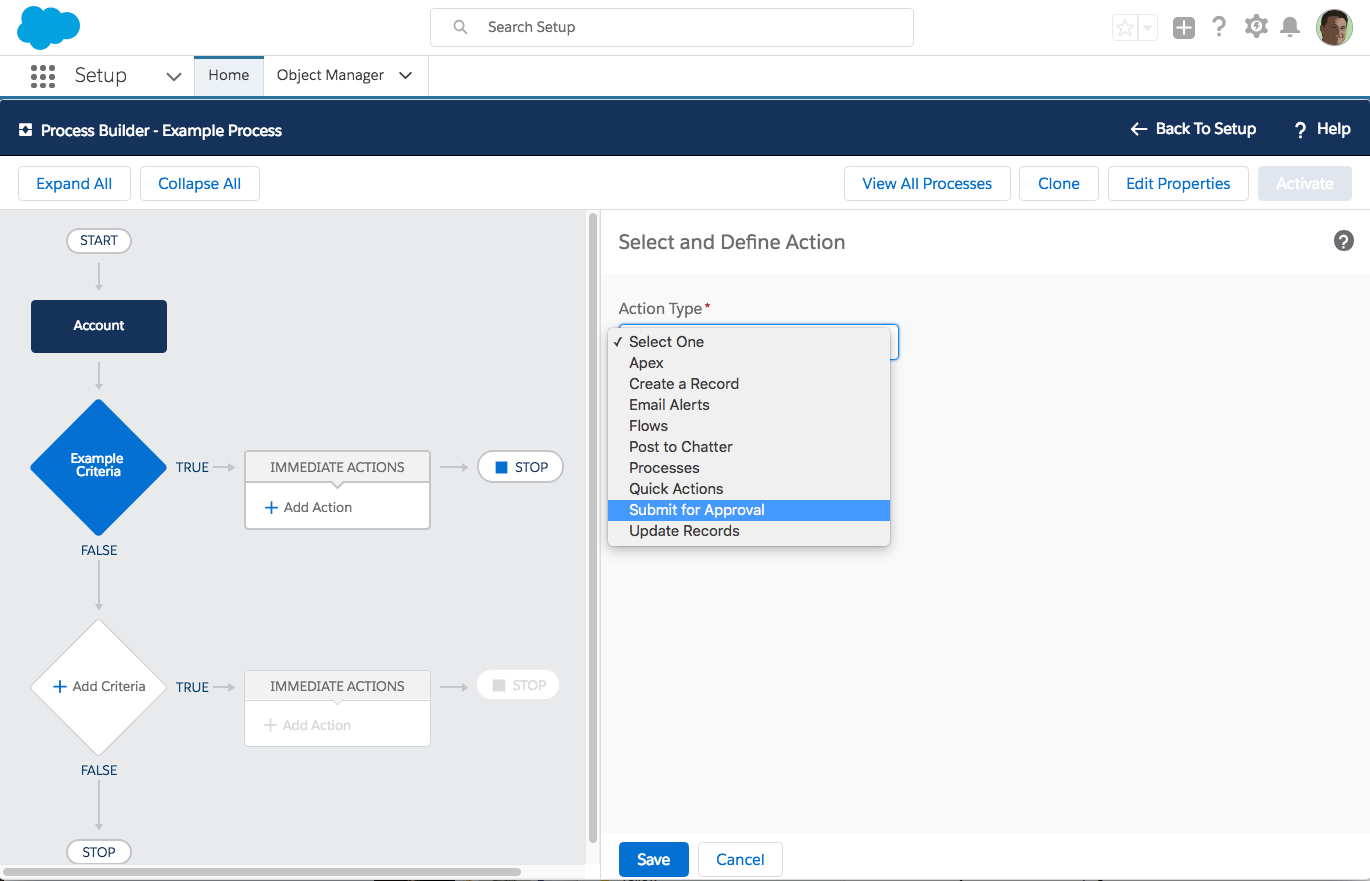
Microsoft Dynamics 365
Microsoft Dynamics 365 has two types of processes: business process flows and workflows.
A business process flow defines a set of steps users follow to achieve a specific, desired outcome such as advancing an opportunity or managing credit checks. These steps should mirror the processes your organization already uses.

Business process flows include a visual indicator to show users where they are in the process. An out-of-the-box example of this is the opportunity progression tracker at the top of each opportunity record:
Completed stages are marked with a check mark, and the current stage is marked with a bullseye.
Within each stage is a series of tasks to complete in order to move to the next stage. Users can view and complete these tasks by clicking on the stage icon.
Business process flows are cross-entity, which means that a process can flow across Leads, Opportunities, Quotes, and custom entities, for example. Processes offer stage gating, which means that specific record updates need to occur in order for a user to be able to progress to the next stage in the process.
Processes are assigned to users based on their Role, which means that salespeople only see sales processes, for example. Based upon permissions, users can switch processes (e.g. a new opportunity versus a renewal opportunity that may have different business processes).
System administrators can configure or create business process flows using a drag-and-drop editor:
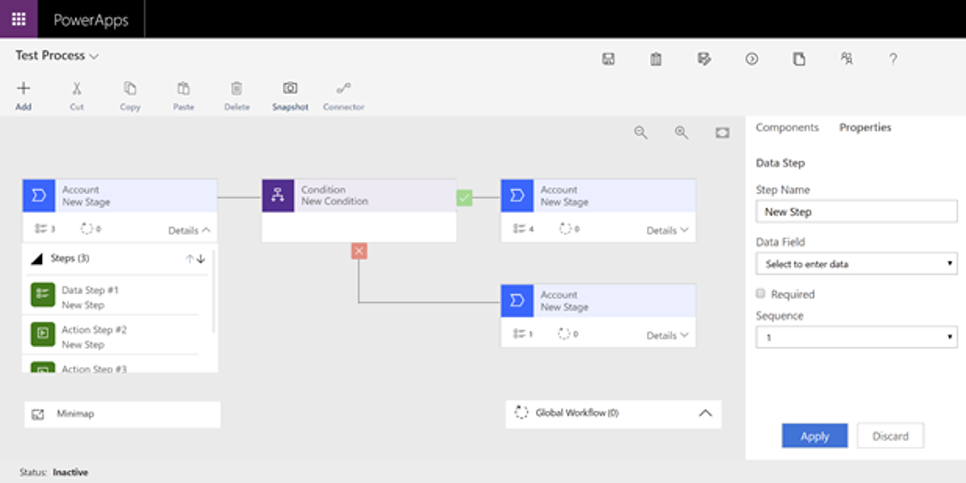
Actions enable users to perform operations such as Create, Update, Delete, Assign, or Perform Action. Importantly, actions create custom messages inside the system that developers refer to as “messages.”
By default, each of these messages is based on the actions taken on an entity record. That means every system default action message is defined by the capabilities of the entity being acted on—not necessarily by business processes or terminology.
Actions enable users to define their own process-driven message terms to match the operations they need to perform, rather than relying on system defaults based on what can be done with an entity. This makes it easier for non-developers to update or even build custom apps once these actions have been defined.
Reporting & Dashboards
Reporting is an area that CRM vendors are continually working to improve in order to meet customer expectations.
Salesforce
Salesforce report creation begins with the selection of a Report Type. There are standard and custom report types. Custom report types allow an administrator to define which objects to display to users when they create reports and to also define relationships among these displayed objects for cross-object reporting. Up to four objects can be associated with a Custom Report Type.
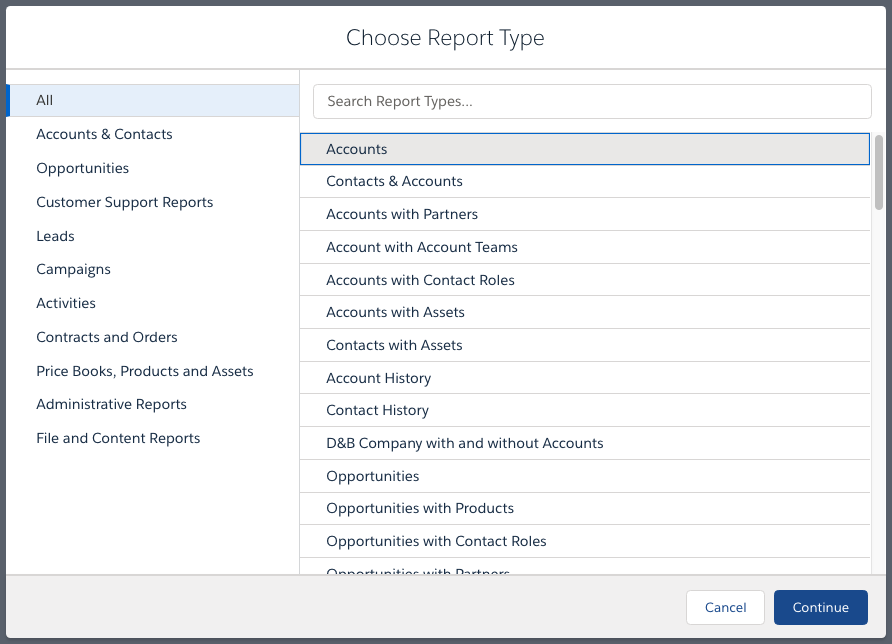
The Salesforce report writer is drag and drop. It includes filters as well as row and column groupings. Fields from a report’s objects, as defined by a Report Type, can be clicked and dragged by a user to add columns and to create groupings.
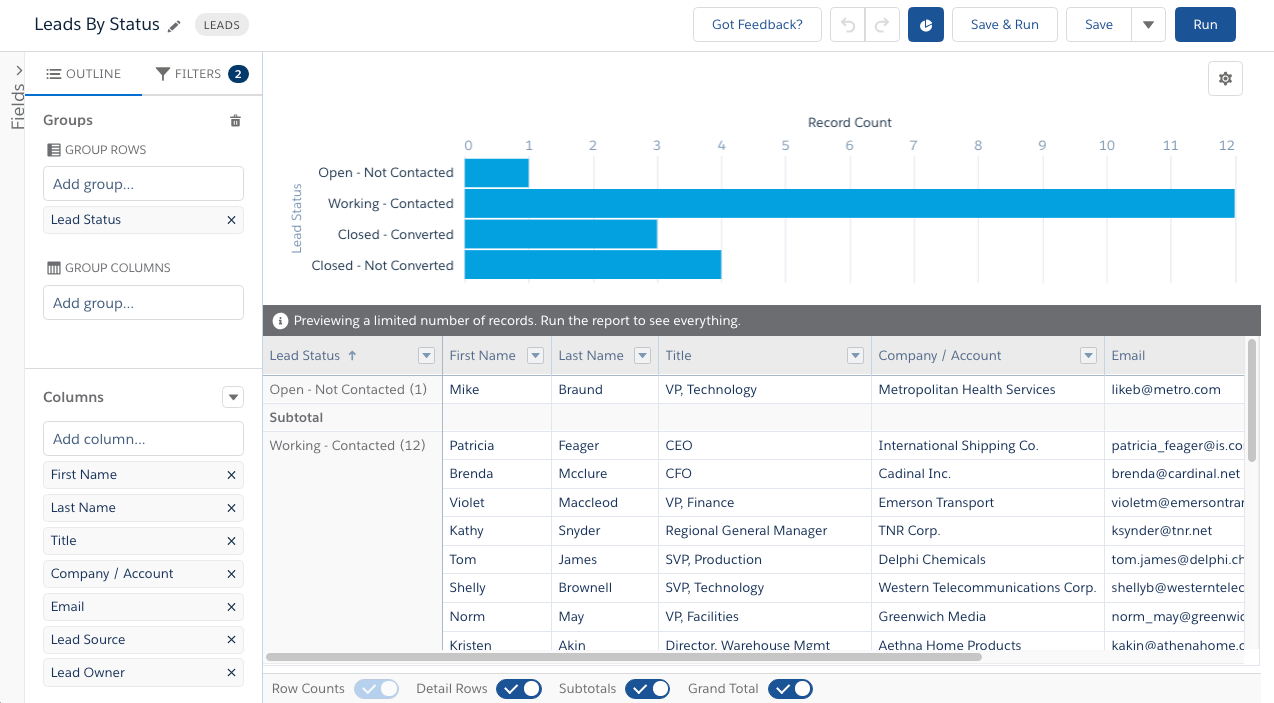
Reports can have associated charts. The Chart Editor allows for defining a chart type and chart data points.
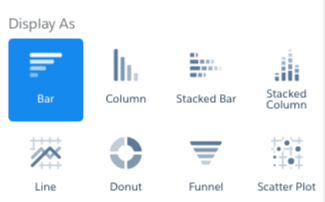
In the Enterprise edition and higher, reports can be automatically delivered via email on a scheduled basis to licensed Salesforce users. Report data appears within the body of an email as formatted text.
Lightning Professional and higher include Customizable Dashboards. Multiple collections of report-based charts can be arranged on a tab as different Dashboards. Salesforce has a default Adoption Dashboard which provides information about what extent different users are using the application.
Also in the reporting category, Salesforce has Forecasting functionality. Quotas can be set per salesperson, and then Opportunity forecast categories can be correlated with quotas, by time period.
Microsoft Dynamics 365
Microsoft Dynamics 365 has a Report Wizard for creating new reports. A new report can be based on an existing report. Reports can be filtered based on existing Saved Views or new filters can be added during report creation.
Another form of reporting is integrating Views with Excel.
Further reporting with business analytics/intelligence is available through PowerBI with its many templated reports. For many Microsoft customers, this is included in their Office 365 subscription.
Reports allow for a Primary record type and a Related record type.

Groupings and columns can be selected by clicking on boxes in the Lay Out Fields dialog.
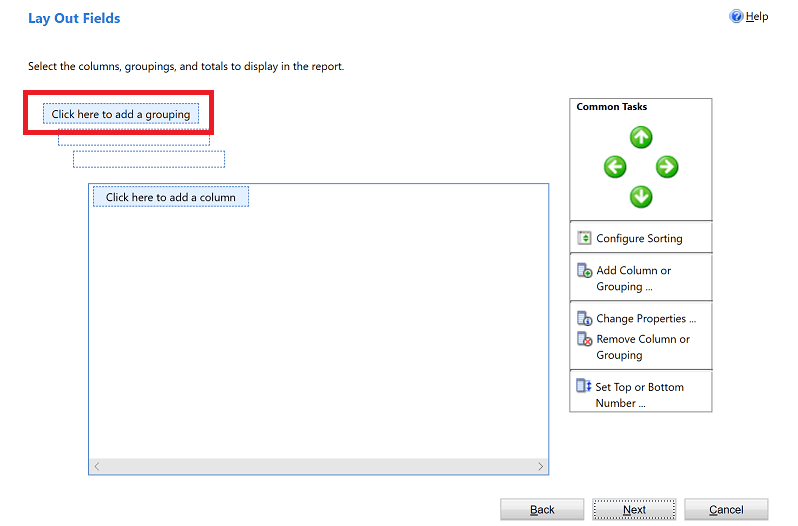
Microsoft Dynamics 365 allows for a number of dashboard formats to be selected.
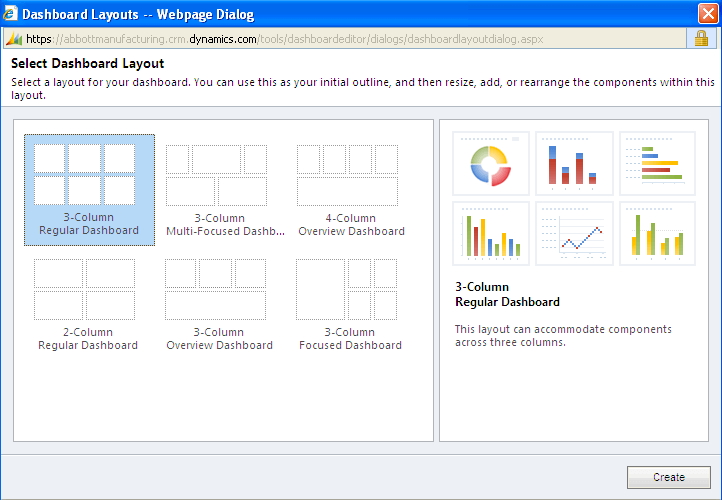
Dashboards in Dynamics 365 can display a combination of views, charts, videos, and web pages, but the most common components are views (Excel-style tables) and charts.
Microsoft Dynamics 365 dashboards are real time and can pull information from any entity within the application. Each module and entity has a default dashboard, so the first thing a user will see when they log in or click on an entity in the Site Map is their default dashboard for that area.
Another form of reporting is integrating Views with Excel.
Further reporting with business analytics/intelligence is available through PowerBI with many templated reports. For many customers, this is included in their Office 365 subscription.
Email Integration
Sales users of CRM, in particular, spend much of their day in email. It’s important to sales and other users to not only be able to log inbound and outbound emails, but to also have a scaled-down CRM experience within their email client. As such, there should be an assessment as to how a prospective CRM system integrates with a company’s standard email client(s).
Salesforce
Salesforce provides a free plugin for Microsoft® Outlook® called Lightning for Outlook. Microsoft Outlook on the web, Outlook 2016, Outlook for Mac 2016, and Outlook 2013 are all supported.
Salesforce Lightning for Gmail is offered in the Chrome store.
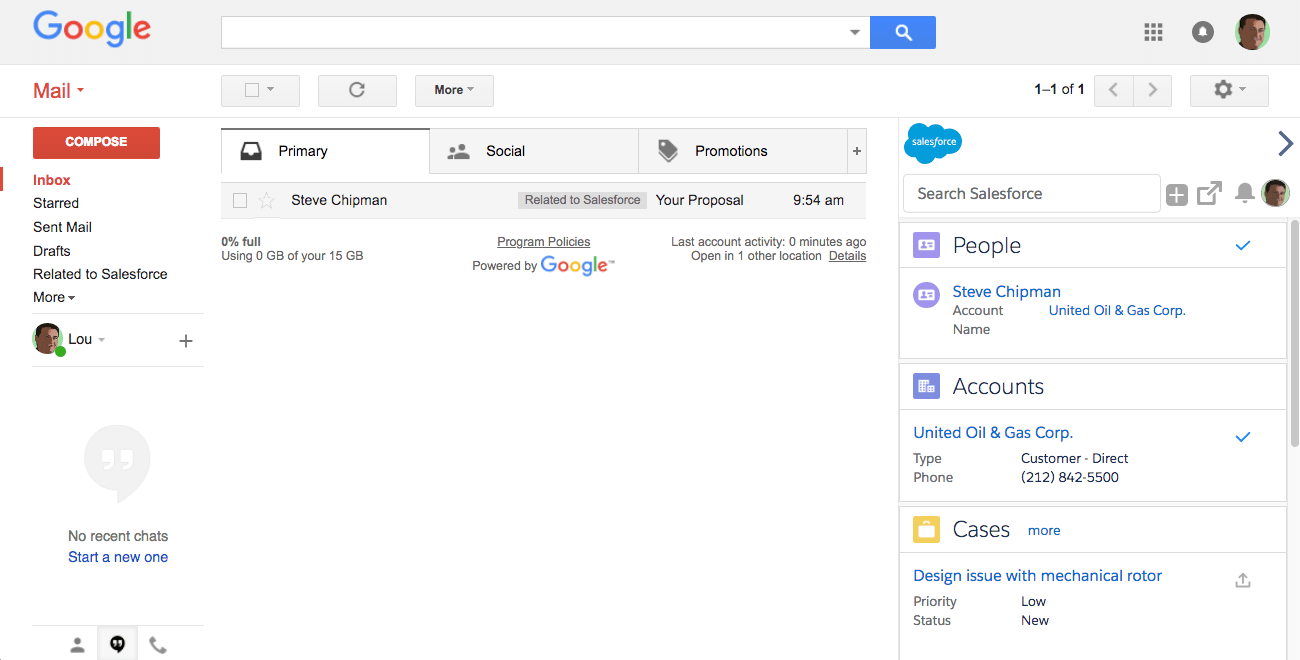
Lightning Sync, for synchronizing Contacts and Events, is available for both Microsoft Exchange and G Suite.
Salesforce also provides a form of universal email integration called “Email to Salesforce”. Each org has its own defined Email to Salesforce address, which, when BCC’d on sends or on forwards of inbound email, will automatically associate sent/received emails with Lead or Contact records in Salesforce that have a matching email address.
Microsoft Dynamics 365
Microsoft Dynamics 365 integrates with Outlook using the Dynamics 365 App for Outlook. With this add-in, the full capabilities of Microsoft Dynamics 365 are available inside Outlook, so users don’t need to tab back and forth between programs.
Users can automatically track all email and appointments within Outlook. Or users can manually track individual emails with just a few clicks.
The Set Regarding drop down list populates based on the content of the email vs. the information in CRM, and presents a user with the records the user is most likely working on.
With one click, a user can link Outlook activities (tasks, emails, appointments etc) to any record in CRM.
Users can convert emails to records, such as Opportunities, in CRM. Users can also create new records directly from Outlook and then link emails to those records in CRM. Users can access email templates with CRM custom fields from within Outlook.
Email Merge
For many users, being able to create email templates rather than always composing an email from scratch is a big time saver. CRM is a convenient platform from which to send templates with merged customer or prospect data.
Salesforce
Salesforce allows administrators and users to create email templates. Templates can be text, HTML, or they can be defined using Salesforce’s Visualforce markup language. A template can be used to send a single email to a Lead or a Contact. A view can be used to send an email to multiple recipients.
Email merges can be sent through Salesforce’s servers or through an External Email Service—Outlook or Gmail.
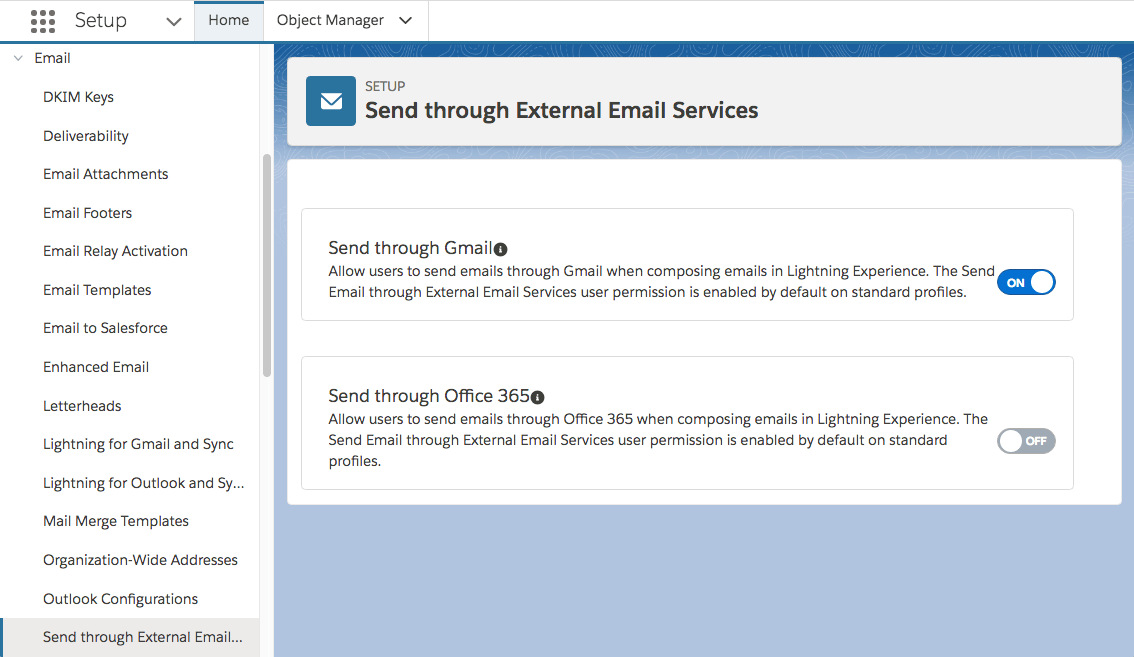
There is a daily email limit of 5,000.
Microsoft Dynamics 365
In Microsoft Dynamics 365, email templates can be created by users or administrators. Template-based emails can be sent to one or more records in a view from within CRM, or using Outlook, whichever platform the user prefers.
The email template integration with Outlook is seamless—users just need to click on the Dynamics 365 button in Outlook. Then they can click the template icon and select “Add Template”:
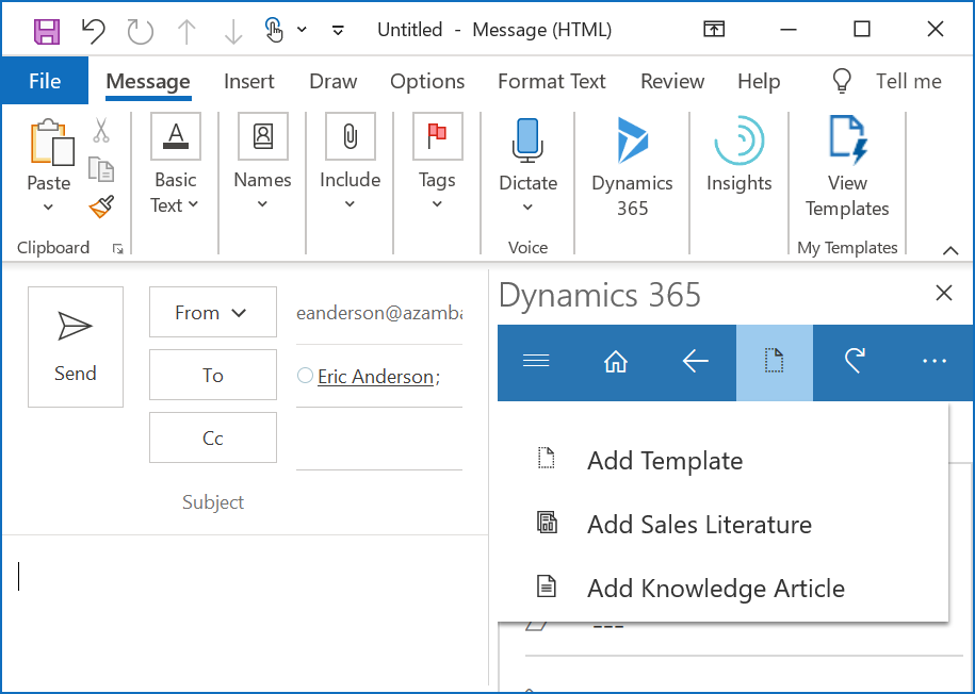
Users can also send Sales Literature or Knowledge Articles from CRM without leaving Outlook. Email templates can use data fields with CRM information to personalize messages.
Microsoft Office Integration
There are a number of use cases for generating documents from CRM. One is creating a report that displays rows from multiple child records. Another is merging pricing tables and other data into long form proposals.
Salesforce
Salesforce relies on third party applications such as Conga Composer and Nintex for merging data into Microsoft Word, Excel and PowerPoint files.
Microsoft Dynamics 365
Microsoft Dynamics 365 allows for exporting select records from a view to Excel Online for inline editing, Excel as a static worksheet, or as a dynamic PivotTable or a worksheet that’s linked back to the source data.
Upon opening dynamic workbooks, all data is refreshed.
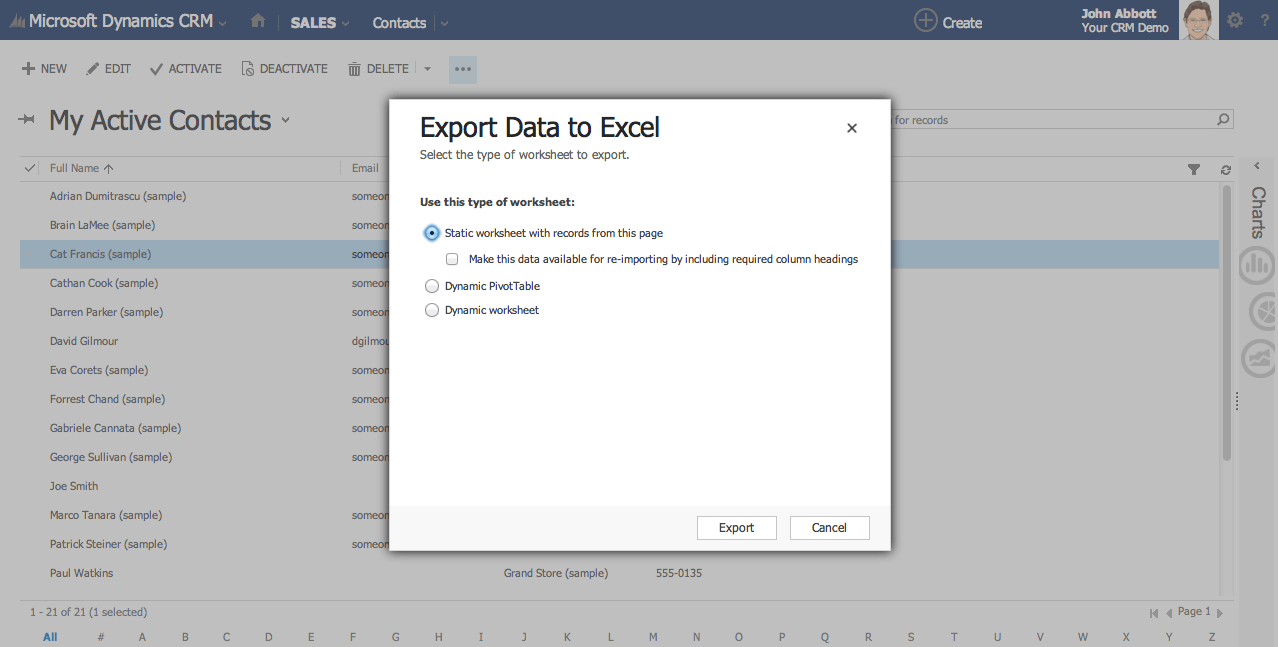
A mail merge can be done using a Word template.

Data Import Tools
Salesforce
Salesforce’s Import Wizard allows for importing a list of records into the Lead object. Records can also be imported as Accounts and Contacts in a single operation.
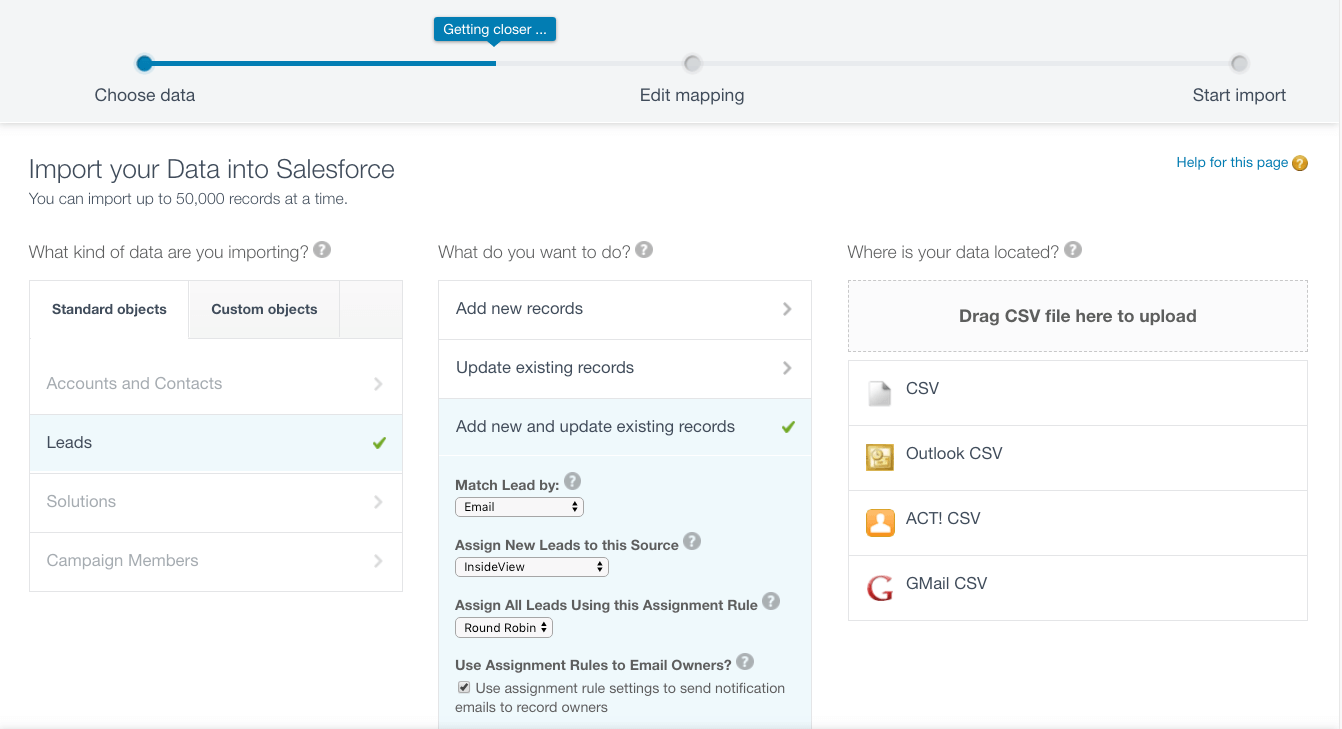
In the Enterprise edition and higher, an application called Data Loader can be used for importing data into any Salesforce object. The Data Loader has a graphical user interface, but can also be run in command line mode, which supports using relational databases as sources and targets.
Microsoft Dynamics 365
Microsoft Dynamics 365’s Import Data Wizard allows for importing data to any Record Type in the database.
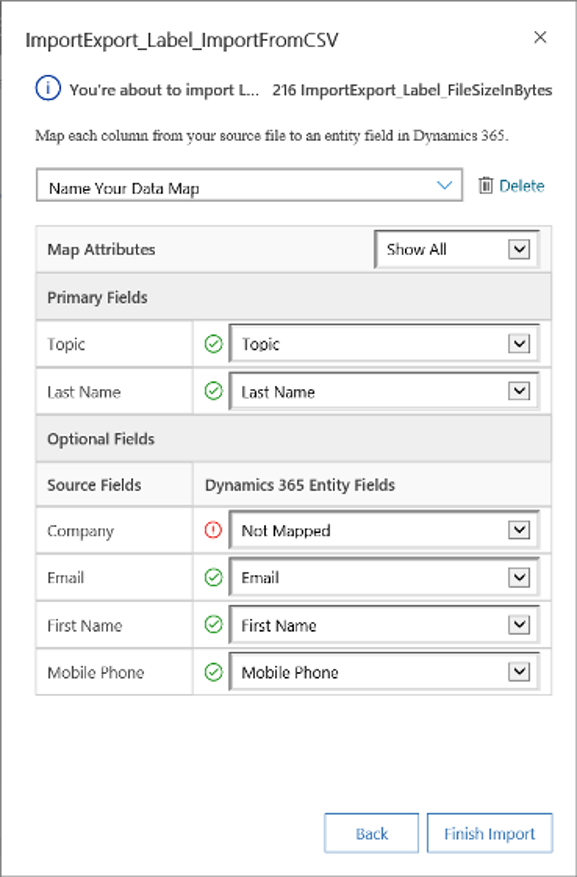
Web Lead Capture
Sometimes, marketers want a quick way to capture “Contact Us” form submissions into a CRM system.
Salesforce
In Salesforce, a wizard allows an administrator to generate “Web-to-Lead” HTML based on selected Lead fields. This HTML can be added to any website, where formatting and validation rules can be applied.
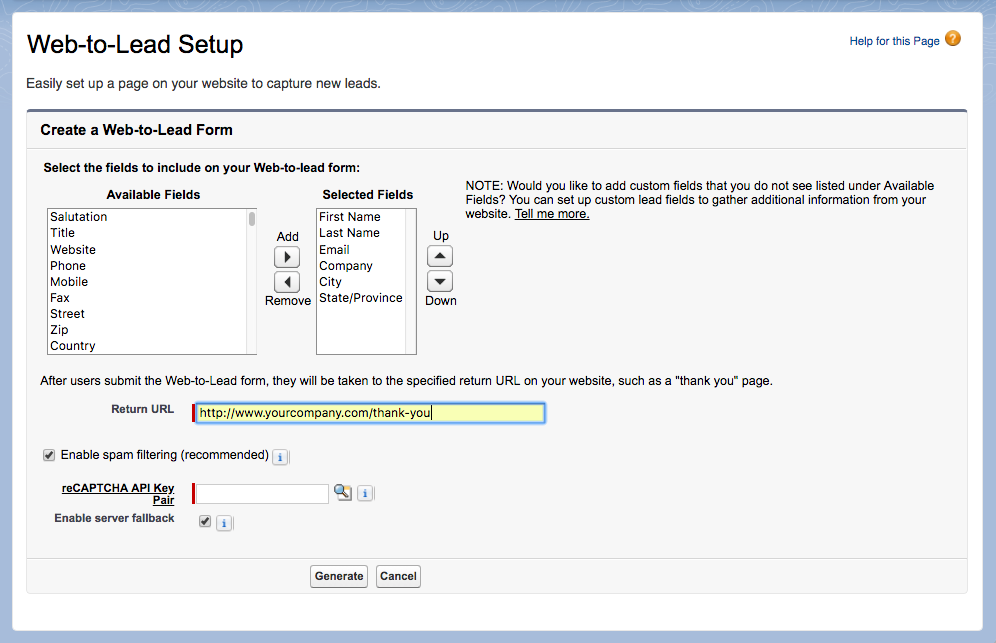
Microsoft Dynamics 365
Lead capture can be accomplished in Microsoft Dynamics 365 using the Portals functionality.
Email Marketing and Marketing Automation
Many organizations evaluate email marketing and marketing automation systems alongside their CRM evaluations.
Salesforce
Through the acquisition of ExactTarget, which had previously acquired Pardot, Salesforce offers both email marketing and marketing automation solutions as part of its product family. The ExactTarget, Buddy Media and Radian6 acquisitions were blended into Marketing Cloud. Marketing Cloud is generally positioned as a B2C solution. Pardot is generally positioned as a B2B solution.
Microsoft Dynamics 365
After relying on third party marketing automation applications since inception of the CRM product, Microsoft released Dynamics 365 for Marketing in 2018.
The marketing product connects to LinkedIn, which Microsoft also owns. LinkedIn integration required the paid Lead Generation capability of LinkedIn to capture leads.
Customer Service / Case Management
Case management can be thought of as trouble tickets or other support/service requests that teams needs to process. This functionality is important to manufacturers, software developers and service providers.
Salesforce
Salesforce offers Case management in its standard Sales Cloud in the Professional Edition and higher. Features include Web-to-Case, Email-to-Case and Customer Communities.
Communities is the Salesforce portal offering. There is an additional cost for Communities.
Since Salesforce has built-in email services, threaded email communications between a Case owner and a customer, within a Case, can be set up without any external components.
Salesforce offers enhanced customer service functionality as part of the Service Cloud. The Service Cloud is a more expensive user license ($135 per user per month for the Enterprise Edition) that adds a number of components, including an Agent Console view, CTI, Community, Knowledge, Social, Live Agent, Social Networking Integration and Contracts & Entitlements (SLAs).
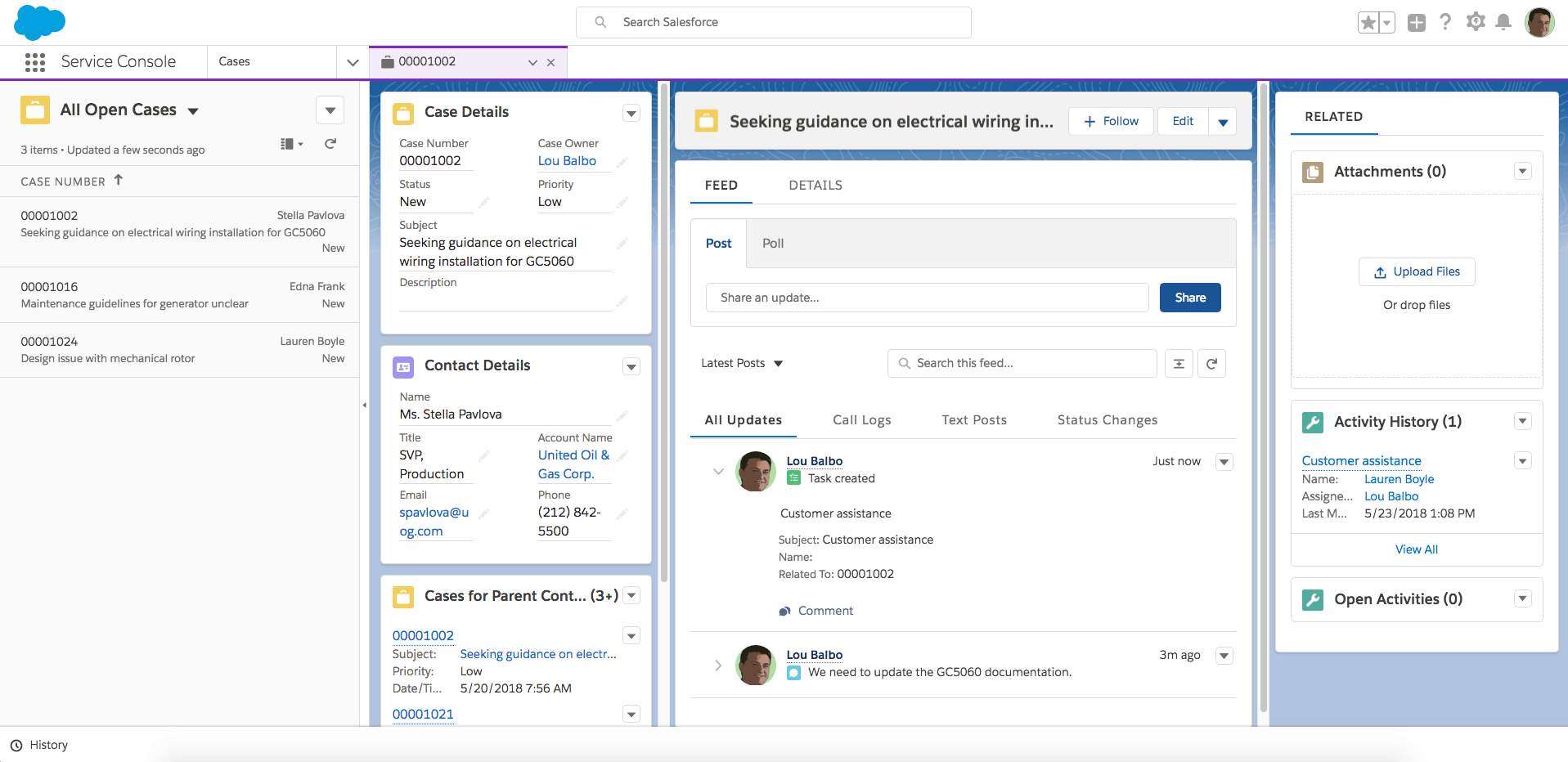
Microsoft Dynamics 365
Microsoft offers Microsoft Dynamics 365 for Customer Service as well as Microsoft Dynamics 365 for Field Service. Customer Service includes Cases, Service Calendar and Queues. Field Service includes optimized scheduling, service agreements, inventory management and mobile device access.
Microsoft also offers portals, which can be used for customer and employee self service and more. Portals is included in Microsoft’s Customer Engagement Plan.
Data Enrichment
Many organizations are looking to reduce the number of fields on web forms. They also want to minimize data entry for salespeople.
Salesforce
Salesforce recently retired their proprietary Data.com record enrichment product. Salesforce now recommends selecting a third party data enrichment tool from the AppExchange.
Microsoft Dynamics 365
There is a free version of InsideView for higher editions of Microsoft Dynamics 365 called Insights.
Example Use Case: Big Data and CRM
Another value our consulting customers have found is the ability to find potential Leads by identifying new companies and contacts.
When big data is connected to CRM, a sales team that’s expanding their efforts toward a new industry can use the connection to search for companies in their geographic area by industry. They can then populate CRM with lists of Leads or Contacts. Records include full name, email address and phone number.
Artificial Intelligence
One of the ways that AI or machine learning can be applied to CRM is to guide users to take actions that will have higher probabilities of successful outcomes, based on the past outcomes of similar activities.
Salesforce
Salesforce offers Sales Cloud Einstein, which can, among other things, predicts which leads and opportunities are most likely to convert.
Einstein, in conjunction with Salesforce Inbox, automates the creation of new contact records and roles.
Einstein, which includes Salesforce Inbox, costs $50 per user per month.
Microsoft Dynamics 365
In September 2018, Microsoft announced AI and mixed reality business applications for Microsoft Dynamics.
Enterprise Social Networking
Salesforce
Salesforce’s enterprise social networking and collaboration platform is called Chatter. Licensed Salesforce users are automatically Chatter users. Each Salesforce org also comes with 5,000 Chatter Free users (for internal users) and 50 Chatter External users.
Files and links can be associated with Chatter posts. Chatter feeds can be enabled for any object. Up to 20 fields per object can be tracked. When a field is tracked, changes to that field update the Chatter feed for that object.
Each user can select from a variety of Chatter email notification options, based on their personal preferences.
Salesforce allows for the creation of Chatter Groups. If a Group is made private, people outside the organization, such as customers, can be invited to the Group and can log in using a Chatter External user license.
Microsoft Dynamics 365
Microsoft Dynamics 365 has Posts capabilities. Each app has its own Posts area, in which users can create new posts and reply to as well as like existing posts.
Dynamics 365 can be connected to Yammer.
Why ESN?
Enterprise social networking is often not a part of a CRM evaluation process. However, for some organizations, ESN can produce big dividends. Here is a use case for a client we worked with recently.
The client’s sales and product development teams often collaborate during the sales cycle for custom developed products.
A salesperson gathers requirements from the prospect. They then ferry information back and forth with product development before developing a quote. The questions were:
1. How can this be done more efficiently?
2. How can communication threads and documents be more easily visibile to others in the organization, including sales management and manufacturing?
Enterprise social networking can allow users to link comments, questions, answers, files and open tasks to leads and to sales opportunities.
Anyone in the organization can look at a sales opportunity can see a record of all items that relate to that opportunity.
For companies that collaborate internally to make a sale or service a customer, enterprise social networking may well be a hidden CRM gem.
Online Help & Training
Salesforce
Salesforce provides a Help & Training console to licensed Salesforce users and administrators. The console includes a searchable knowledge base, FAQs, documentation, videos and other resources. Help & training is a part of the Salesforce Trailblazer Community site which also includes Answers, collaboration (Chatter), Ideas, user groups and known issues.
Microsoft Dynamics 365
Microsoft Dynamics 365 has a community site that’s part of a larger community site that covers all Dynamics lines. The site offers blogs, videos, community conversations, a knowledge base and other resources.
Conferences
Salesforce
Salesforce’s annual Dreamforce conference is held in San Francisco in the fall. This conference is for customers, partners and ISVs. The 2020 conference is virtual and is called “Dreamforce to You.”
Microsoft Dynamics 365
Microsoft’s annual tech conference, held in the fall, is called Ignite.
CRMUG Summit is a CRM specific conference that is held in the fall.



